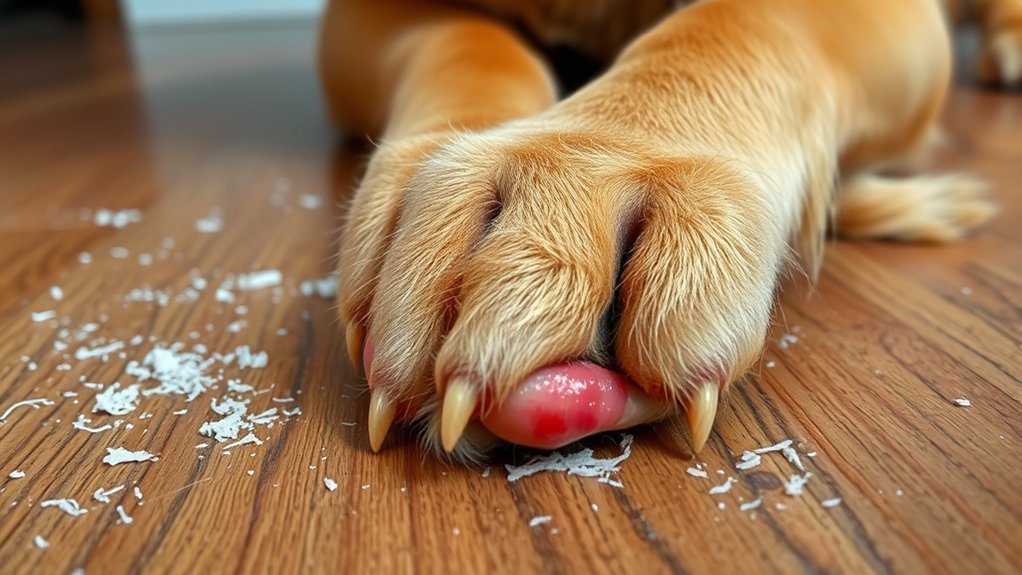8 Common Dog Skin Allergy Signs
Dog allergies can be tough for our furry friends. Spotting the signs early helps keep them comfortable. Look out for these common symptoms:
- Scratching: If your dog is scratching a lot, it might mean they have an allergy.
- Red or Inflamed Skin: Look for any redness on their skin. This can be a sign of irritation.
- Bumps or Hives: Fluid-filled bumps may appear on their skin.
- Foul Odors: If your dog has an unusual smell, it could mean they need help.
- Hot Spots: These are bare, red patches on the skin that may feel warm.
- Excessive Licking: If your dog licks their skin often, they may be trying to soothe an itch.
- Hair Loss: Noticeable thinning or bald spots can happen due to allergies.
- Ear Infections: Allergies can lead to more frequent ear issues.
If you see any of these signs, talk to your vet. They can help figure out what's causing the allergy and suggest ways to help your dog feel better. Keeping an eye on these symptoms helps keep your pet happy and healthy!
Key Takeaways
8 Common Signs Your Dog Has Skin Allergies
- Scratching and Itching: If your dog is scratching a lot, especially on its face, paws, or belly, it might have skin allergies.
- Red or Inflamed Skin: Look for red, sore patches on your dog's skin. This can mean an allergic reaction, and you should see a vet to avoid infections.
- Hot Spots: Sometimes dogs create painful red spots from licking or scratching too much. These need quick care to help your dog feel better.
- Hair Loss: If you notice your dog losing fur or having spots of thinning hair, allergies or pests might be the reason. This can hurt their skin health.
- Bad Smell: A strong odor from your dog's skin could mean an infection or allergies. A visit to the vet is a good idea to find out what's going on.
Keep an eye on these signs. If you notice any, talking to your vet can help your furry friend feel better soon!
Excessive Scratching and Itching
If your dog starts scratching a lot and itching, it might mean they've a skin allergy. Take a moment to think about what could be causing these allergies. Some common things that might be bothering them include pollen, grass, and mold, especially during certain times of the year. These can make your furry friend uncomfortable and irritable.
You might see your dog scratching more on their face, paws, or belly. Paying attention to when this happens can help you figure out what's causing the problem. Look at where your dog spends time, what they eat, and how often you groom them. This information can help you manage their itching better.
If your dog keeps scratching and it doesn't stop, it's a good idea to visit the vet. They can help find out what's wrong and suggest the right treatment.
Your dog's comfort is important, so don't wait too long if they seem to be in distress!
Red or Inflamed Skin
Red and inflamed skin on your dog can mean they've a skin allergy. You might see this redness on different parts of their body. It could be from food, bugs, or things in the environment that they're allergic to.
Check for any warm areas on your dog's skin or places that are swollen.
If you notice these signs, it's important to act quickly. Ignoring red, inflamed skin can lead to infections or other serious problems.
Talk to your veterinarian. They can help you figure out what's causing the allergy and suggest how to treat it. Taking care of your dog's skin not only helps them feel better but also makes your bond even stronger.
Hot Spots
If your dog has skin problems, look out for hot spots. These are painful, red areas that can happen when your dog licks or scratches too much. Hot spots can grow quickly, so acting fast is important.
To help prevent hot spots, groom your dog regularly and keep their skin clean and dry. If you spot a hot spot, clean it gently with a mild antiseptic.
It's also a good idea to talk to your vet. They might suggest treatments like corticosteroids or antibiotics.
Dealing with hot spots early can stop them from getting worse. By keeping an eye on your dog's skin and acting quickly, you'll help keep them comfy and healthy.
This care will help strengthen your bond with your furry friend.
Hair Loss or Thinning Fur
If your dog is losing hair or has thinning fur, it could mean something isn't right with their health. There are several reasons why this might happen, such as allergies, parasites, or changes in hormones. If you see these signs, you should look into it.
Allergies, especially to food or things in the environment, can make your dog itchy and cause hair loss. Fleas and other bugs can also make things worse.
You can try some natural remedies to help. For example, giving your dog omega fatty acids can improve their coat. Regular brushing can help too, as it keeps their fur nice and removes anything that might irritate their skin.
Always talk to your vet before starting any treatment for hair loss. Taking action quickly will help your dog feel better, stay healthy, and strengthen the bond you share as you care for them.
Skin Scabs or Lesions
Taking care of your dog's skin is important, especially if you see scabs or sores. These problems might mean your dog has allergies, irritation, or an infection. It's a good idea to keep an eye on your dog's skin for signs like redness, swelling, or if they're scratching a lot.
Check your dog regularly and watch for any changes. Treating these skin issues can involve using ointments, medicated shampoos, or sometimes medications from your vet.
Keeping your dog's space clean and free of allergens can help stop these problems from happening again.
If you're not sure what to do, talk to your veterinarian. They can help you come up with a good plan for your dog's skin health.
Taking care of scabs or sores quickly can make your dog feel better and help you bond with them even more. Your furry friend will appreciate your care!
Odor or Unpleasant Smell
When your dog smells bad, it might mean there's a problem. This could be due to allergies, infections, or not being clean enough. Often, a bad smell comes from bacteria on irritated skin, especially if your dog has allergies.
To help, give your dog regular baths using gentle shampoos made for sensitive skin. This can help reduce odors and keep their skin clean.
If your dog still has a bad smell even after bathing, it's important to visit the vet. They can find out what's wrong and help with any allergies.
Don't ignore this issue. If it's not treated, it could lead to bigger problems like infections.
Changes in Behavior
Changes in behavior can mean your dog might've skin allergies. You may see signs of anxiety or your dog might seem more tired than usual. It's important to notice these changes because they affect your dog's health.
Here are some behaviors to keep an eye on:
- Scratching or licking more than normal, which shows they might be uncomfortable.
- Not wanting to play or hang out with you and other pets.
- Pacing or not being able to sit still, which can be a sign of worry.
- Eating less or more, which can change their weight.
Spotting these signs early can help you take care of your dog better. If you see any of these changes, talk to your veterinarian. They can help you understand what's going on and how to help your furry friend feel better.
Ear Infections or Ear Inflammation
If you see your dog acting differently, it might mean they've a health problem, like an ear infection or inflammation. Look for signs such as scratching their ears, shaking their head, or strange smells coming from those ears.
Keeping your dog's ears clean is very important. Regular cleaning helps prevent dirt buildup and infections.
If you think your dog has an ear issue, talk to your vet. They can suggest treatments based on what's wrong. This might include ear drops, antibiotics, or antifungal medicine.
Catching ear problems early can help stop more serious issues later.
Frequently Asked Questions
How Can I Differentiate Between Allergies and Other Skin Conditions?
To tell the difference between allergies and other skin problems, you can start with skin tests. These tests help find out what might be causing your allergy.
Watch for patterns in your skin issues. For example, if your skin flares up in certain seasons, it may be linked to allergies. Tracking when and where your skin reacts can help you know what the problem might be.
This simple approach can help you get a clearer picture of what's going on with your skin.
Are Certain Dog Breeds More Prone to Skin Allergies?
Some dog breeds can get skin allergies more easily than others. If you have one of these breeds, it is important to take care of their skin and keep them comfortable. Knowing if your dog breed is at risk helps you take steps to prevent allergies. This way, your furry friend can stay healthy and happy.
Can Dog Allergies Cause Gastrointestinal Issues?
Yes, dog allergies can cause stomach problems. When dogs have food allergies, they might get sick. This can show up as vomiting or diarrhea. If you see these signs in your dog, talk to your vet. They can help you figure out what's wrong and how to treat it. Your dog's health is important, so always check with a professional if you have concerns.
What Home Remedies Help Alleviate Dog Skin Allergies?
If your dog has skin allergies, here are some home remedies that can help.
First, try giving your dog an oatmeal bath. Oatmeal can soothe their skin and make them feel better. Just mix some ground oatmeal in warm water and let your dog soak for about 15 to 20 minutes. This can give them some relief from itching.
Next, you can apply coconut oil to your dog's skin. Coconut oil is great for moisturizing. It can help reduce irritation and make your dog's skin feel more comfortable. Just put a little on the affected areas and gently rub it in.
These simple remedies can help your furry friend feel more relaxed and happy!
When Should I See a Veterinarian for My Dog's Skin Issues?
If your dog's skin problems don't get better with home care, worsen, or seem to cause a lot of pain, you should see a vet. The vet can find out what is causing the irritation and suggest the best treatments for your dog.






